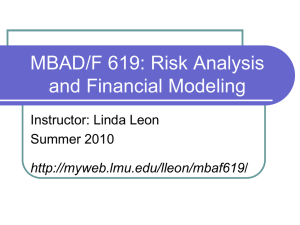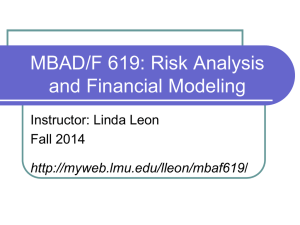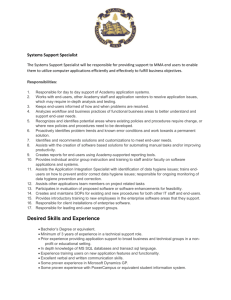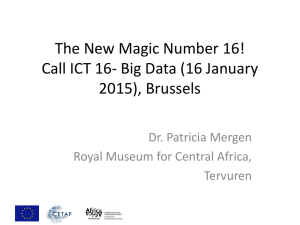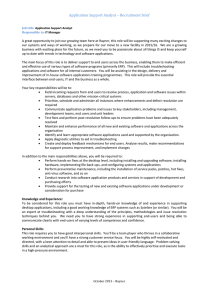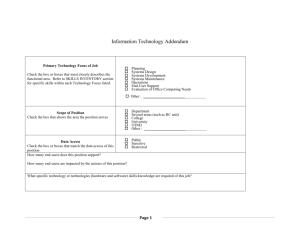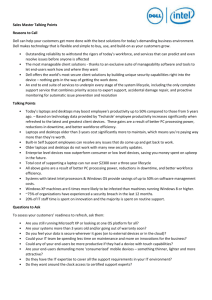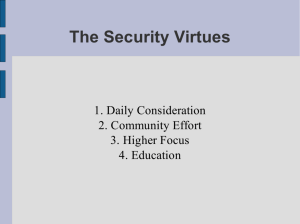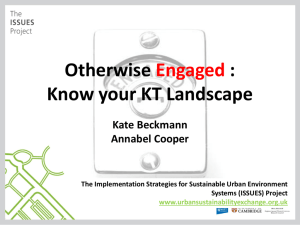THE SERVICE OUTPUT DEMANDS
advertisement
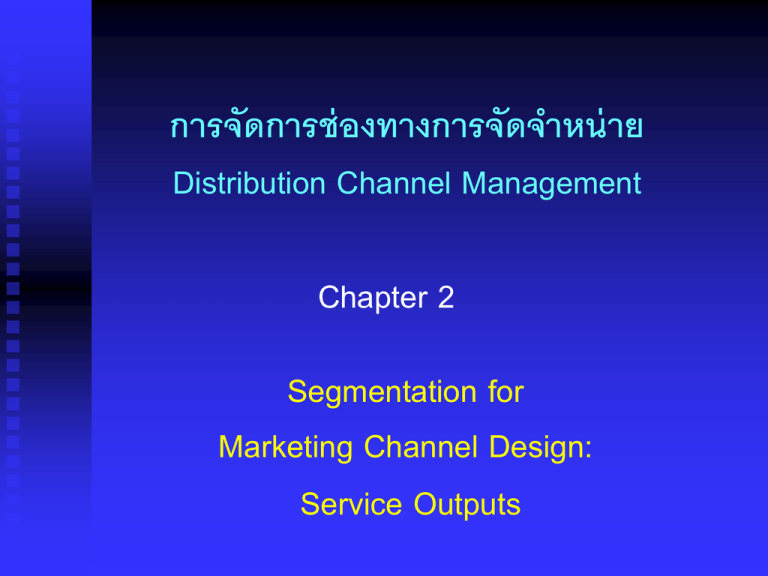
การจัดการช่ องทางการจัดจาหน่ าย Distribution Channel Management Chapter 2 Segmentation for Marketing Channel Design: Service Outputs Chapter 2 Outlines Learning Objectives - Understand the central role played by end-users and their demands in the design of marketing channels. - Know what service outputs are and how to identify and analyze them. - Be able to divide market into channel segments for the purpose of designing or modifying a marketing channel. - Be able to evaluate when and whether to try to meet all expressed service output demands in the short run in a particular market. - Understand the relationship between service output demands and solutions to overall channel design problems. Service Outputs Points of Discussion - The importance of end-users (target market) in the planning of marketing activities. - What are the nature of end-users’ demand? (What are the factors influencing end-users buying decision?) - What end-users want to buy? - How end-users want to buy? Service Outputs End-users’ Demand What How End-users Want to Buy? (Features and Benefits) End-users Want to Buy? (Service Outputs) Service Outputs End-users’ Demand in Purchasing a Notebook What How End-users Want to Buy? (Features and Benefits) End-users Want to Buy? (Service Outputs) Generate End-users’ Demand 1) Product attributes; 2) Service Outputs Divide participants into 6 groups • Groups 1 & 2 generate end-users’ demand for a mobile phone. • Groups 3 & 4 generate end-users’ demand for a renown branded apparel. • Groups 5 & 6 generate end-users’ demand for instant noodle. • Send a representative to present your group’s answer. Prentice Hall, Inc. © 2006 5-6 TABLE 2-1: ESTIMATED NUMBER OF U.S. CONSUMERS USING ONLINE BILL PAYMENT, VARIOUS YEARS YEAR # U.S. CONSUMERS PAYING AT LEAST 1 BILL ONLINE (millions, est.) % OF U.S. POPULATION (est.) 1998 3.4 1.3% … … … 2001 20.4 7.3% 2002 25.5 9.1% 2003 35.0 12.5% 2004 65.0 23.0% Notes: 1998: in 1998, just 2% of U.S. households used online bill payment, according to Tower Group (Bielski 2003). From U.S. Census data, in 1998, there were 100 million households in the U.S., with an average of 1.7 adults per household; thus, 2 million households or 3.4 million adults were using online bill payment in 1998. 2001: A Forrester Research report said that nearly 17 million U.S. households will pay bills online in 2002, up 41 percent from 2001 numbers (Higgins 2002). Thus, in 2001, 12 million U.S. households paid bills online. From U.S. Census data, there were 108 million households in the U.S., with an average of 2.58 adults per household; thus, there were 20.4 million adults using online bill payment in 2001. 2002: The same Forrester Research report said that nearly 17 million U.S. households will pay bills online in 2002 (Higgins 2002), while a Tower Group report said that 13.7% of U.S. households did pay bills online in 2002 (Bielski 2003). The table therefore reports the numbers from Bielski. There were 109 million households in the U.S. in 2002; thus, 15 million households paid bills online. Further, there were an average of 2.58 adults per household in the U.S. in 2002 (from U.S. Census data), yielding the estimate of 25.5 million adult online bill payers in 2002. 2003 and 2004: A Gartner study cites 65 million U.S. consumers paying at least some bills online, and reports this is almost twice as many as in 2003 (Park, Elgin et al. 2004). We therefore estimate that 35 million U.S. consumers paid bills online in 2003. TABLE 2-2: ONLINE BILL PAYMENT: THE CONSUMER EXPERIENCE OPTION: Paper Bill Payment Direct Biller Online Pay Third-Party Online Bill Payer (e.g. bank, Quicken) SET-UP PROCESS: None Consumer logs on to biller’s website; Enters information about account, name, bank account fr/which payment will be made, etc.; Picks a password, specific to this website, to gain access in future; Activation usually occurs within 24 hours Consumer logs on to third-party website; Enters information about each account individually; Picks a password, specific to this site but common across all bills paid at this site, to gain access in future BILL PRESENTMAIL TO CONSUMER: Consumer receives bill through U.S. mail in envelope containing summary of bill charges & due date, payment stub, & payment envelope Either through U.S. mail (see paper bill) or electronic bill presentment through e-mail alert; both note payment due date Arrival of electronic bill noted through e-mail alert; Third party may/may not offer actual bill presentment CONSUMER BILL REVIEW AND PAYMENT AUTHORIZATION: Consumer reconciles bill with paper receipts; fills out payment stub; writes paper check; inserts check and stub in envelope; puts U.S. first-class stamp on envelope; mails payment Consumer reconciles bill with receipts; Visits biller website’s payment page; Enters amount and date of payment; [website indicates how fast payment will be made] Consumer visits third party’s website to view bill (if no presentment by third party) and reconcile; Enters amount and date of payment (may need up to 5 days to clear payment) CONFIRMATION OF PAYMENT TO CONSUMER: Only when next bill is received does consumer learn if previous payment was received in time (unless consumer telephones biller) Typically, e-mail confirmation of payment receipt the day payment is recorded Typically, e-mail confirmation that payment was made COST TO CONSUMER: Cost of first-class stamp; No cost to learn system; Cost of time to process bill & write check; Cost of paper check; Risk-adjusted cost of late payment (perceived very low) No monthly fee for payment processing No stamp; Initial learning time, for each biller’s system; Cost of time to check bill’s accuracy; No check writing or cost; Risk-adjusted cost of late payment (perceived low); No monthly fee for payment processing No stamp; Initial learning time, once for whole system; Cost of time to check bill’s accuracy; No check writing or cost; Risk-adjusted cost of late payments (moderate: up to 5 days to clear payment) May be a monthly fee (e.g., Quicken: $9.95/month for up to 20 bills, plus $2.49 per 5 bills thereafter; but many banks now do not charge for service); May be low cost to integrate with home financial records (e.g., Quicken financial software program) FIGURE 2-2: ADVERTISING COPY FOR AN AD FOR BN.COM Advertising Copy Service Output Offered “Really free shipping”: offers free shipping if 2 or more items are purchased. “We make it easy and simple.” Customer service “Fast & easy returns”: end-user can return unwanted books to a bricks-and-mortar Barnes & Noble bookstore. “Just try and return something to a store that isn’t there.” Quick delivery (for returns), spatial convenience; note implicit comparison with amazon.com, the pure-play online bookseller “Books not bait”: promises no additional sales pitches to buy non-book products. Assortment/variety: just books (targeting the book lover). Again, note implicit comparison with amazon.com. “Same day delivery in Manhattan”: delivery by 7:00 p.m. on any item(s) ordered by 11:00 a.m. that day. “No other online bookseller offers that.” Quick delivery: the offer is possible because of Barnes & Noble’s warehouses in New Jersey, near Manhattan. Note direct comparison with other online booksellers (notably, amazon.com) “The gift card that gives more”: can be used either online or in the bricks-and-mortar bookstores, nationwide. Spatial convenience, assortment/variety: when buying a gift for a friend, this provides virtually limitless assortment, and does so anywhere the recipient lives in the United States. “bn.com – 1,000,000 titles; amazon.com – 375,000 titles” Assortment/variety: direct comparison with amazon.com, offering a broader assortment of titles to the consumer Source: advertisement for bn.com in Wall Street Journal, November 20, 2002, p. A11. Service Outputs The meaning of Service Output “The value-added services created by channel members and consumed by end-users along with the product purchased” Service Outputs include - Bulk-breaking - Spatial convenience - Waiting and delivery time - Assortment and variety - Customer service - Information provision Segmenting the Market by Service Output Demands Points of Discussion - The different groups of end-users value service outputs differently. - The constant-sum scale is the most useful approach in determining channel segmentation according to service output demands. - The key factors determining the responsive rate to the unmet service output demands. - The service output demand template. Segmenting the Market by Service Output Demands Different groups of end-users value service output differently High End Low End Very service sensitive Low price sensitive Specialized channel Low service sensitive High price sensitive Multiple marketing channel x Bulk-breaking // Spatial convenience // Waiting and delivery time // Assortment and variety // Customer service x information provision / Bulk-breaking / Spatial convenience x Waiting and delivery time / Assortment and variety x Customer service x information provision TABLE 2-3: BUSINESS-TO-BUSINESS CHANNEL SEGMENTS FOR A NEW HIGH-TECHNOLOGY PRODUCT Respondents allocated 100 points among the following supplier-provided service outputs according to their importance to their company: = Greatest Discriminating Attributes = Additional Important Attributes Lowest Total Cost/ Pre-Sales Info Segment Responsive Support/ Post-Sales Segment Full-Service Relationship Segment References and Credentials Segment References and Credentials 5 4 6 25 Financial Stability and Longevity 4 4 5 16 Product Demonstrations & Trials 11 10 8 20 Proactive Advice & Consulting 10 9 8 10 Responsive Assistance During Decision Process 14 9 10 6 4 1 18 3 Lowest Price 32 8 8 6 Installation and Training Support 10 15 12 10 Responsive Problem Solving After Sale 8 29 10 3 Ongoing Relationship with a Supplier 1 11 15 1 100 100 100 100 16% 13% 61% 10% Possible Service Output Priorities One-Stop Solution Total % Respondents Source: Reprinted with permission of Rick Wilson, Chicago Strategy Associates, 2000. FIGURE 2-1: IDEAL CHANNEL SYSTEM FOR BUSINESS-TO-BUSINESS SEGMENTS BUYING A NEW HIGH-TECHNOLOGY PRODUCT Manufacturer (New High Technology Product) Associations, Events, Awareness Efforts Pre-Sales Sales VARs Internal Support -Install, Training & Service Group Post-Sales Segment TeleSales/ TeleMktg Dealers Full-Service Responsive Support References/ Credentials Source: Reprinted with permission of Rick Wilson, Chicago Strategy Associates, 2000. ThirdParty Supply Outsource Lowest Total Cost Segmenting the Market by Service Output Demands The key factors determining whether and how quickly to respond to knowledge about unmet service output demand include: • Cost • Competitive • Ease of entry • Other elements of excellence in market offering TABLE 2-5: THE SERVICE OUTPUT DEMANDS (SOD) TEMPLATE SERVICE OUTPUT DEMAND: SEGMENT NAME/ DESCRIPTOR BULK BREAKING SPATIAL CONVENIENCE DELIVERY/ WAITING TIME ASSORTMENT/ VARIETY CUSTOMER SERVICE INFORMATION PROVISION 1. 2. 3. 4. 5. 6. INSTRUCTIONS: If quantitative marketing-research data are available to enter numerical ratings in each cell, this should be done. If not, an intuitive ranking can be imposed by noting for each segment whether demand for the given service output is high, medium, or low.
